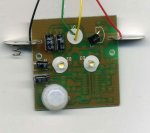There are often posts asking for advice on interfacing PIR sensor and the following information might therefore be of interest. I recently purchased a ‘Uni-Com’ automatic light unit form Maplin Electronics, which contains a PIR sensor and conditioning circuitry on a removable 4cm x 6cm size board. Unlike most readily available PIR units this one is not mains powered but operates from 5-6 volts. It's LED output can therefore be easily be interfaced to a PICAXE digital input.
The traditional (through hole) circuitry is based on a single low power M7615 PIR controller DIL chip from Mosdesign Semiconductor Corp. It is not necessary to understand this circuitry in order to interface the board but, for the inquisitive, it’s probably based on the example given in the MSC data sheet. One modification that may be needed relates to a LDR that inhibits operation in daylight. If this feature is not required, I suggest removing the LDR and shorting the board’s sensor input to ground.
At this price (about £8) it would be difficult to find a cheaper and more convenient way to interface a PIR to a PICAXE.
The traditional (through hole) circuitry is based on a single low power M7615 PIR controller DIL chip from Mosdesign Semiconductor Corp. It is not necessary to understand this circuitry in order to interface the board but, for the inquisitive, it’s probably based on the example given in the MSC data sheet. One modification that may be needed relates to a LDR that inhibits operation in daylight. If this feature is not required, I suggest removing the LDR and shorting the board’s sensor input to ground.
At this price (about £8) it would be difficult to find a cheaper and more convenient way to interface a PIR to a PICAXE.


